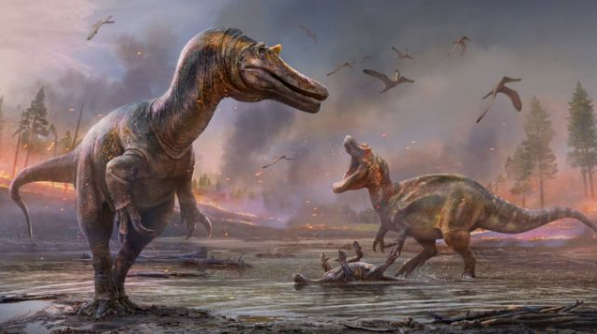New dinosaur species discovered from the Isle of Wight
- Alaya Laubsch
- Oct 4, 2021
- 2 min read

Two new dinosaur species were discovered on the Isle of Wight beach, located on an island off the south coast of England. They were revealed to be carnivorous and belonged to the Spinosaurus species. These new dinosaurs were named 'Riverbank hunter' and Hell heron' after the habitats in which they would have thrived in. It is estimated that they roamed the island 139 million years ago. These specific dinosaurs were estimated to be 9 meters in length with 1-meter skulls. Both species were related to each other and were thought to have lived around a similar time. They differ from each other through their skull features and habitats. The ‘Riverbank hunter’ highlights more of an aquatic, fish-eating nature, whereas the ‘Hell heron reflects a wetland lifestyle. An interesting theory raised from the discovery is that the dinosaurs could have stayed away from each other, roaming different habitats, targeting different prey and operating at different times to avoid competing with each other.
This find is significant because it is exceptionally rare. Spinosaurus fossils are usually fragmentary and missing primary bones. The essential features that were found in this recent discovery were declared to be comparatively intact, with substantial amounts of skull and tail. This allowed the researchers to assess the bone pieces to create an image that displayed what the dinosaurs could have looked like. Several other fossil fragments, like teeth, have been discovered around the area, although this recent find allowed more information to be processed. It took over 7 years to unearth and assemble a collection of the 50 bones that were found in fragments over the period.
The species Spinosaurus means “Spine lizard”, and they were the biggest carnivorous dinosaurs, towering over the Tyrannosaurus and Giganotosaurus. The body length of the species was around 14-18 meters, with a height of 5.5 meters, a skull of 1.75 meters and an estimated mass of 12,000-20,000 kg. They lived during the Cretaceous period, around 97 million to 113 million years ago. Prominent spines grew out of the species’ back vertebrates, reaching up to a length of 2.1 meters. The bone structure imitates one of a crocodile, with a long, rounded V-shaped snout and conical teeth. Recent discoveries state that the Spinosaurus was an aquatic dinosaur, surviving mainly on fish such as sawfish, sharks and large lungfish.
These new fossil discoveries are vital to understanding how these species spread across the world. The discoveries also raise awareness about the powerful species’ history and relatives. Researchers can then confide in reliable material to piece together the dinosaurs’ travelling routes and other potential fossil locations.
Sources:






Comments